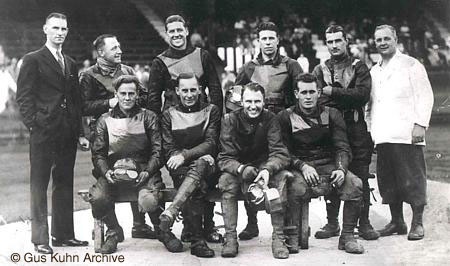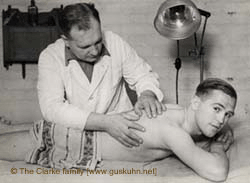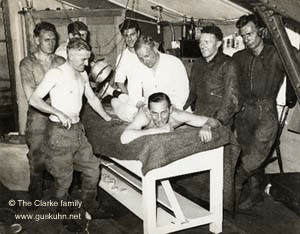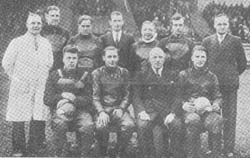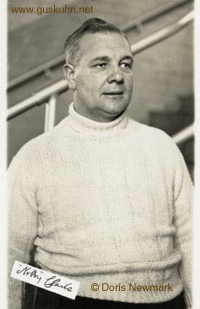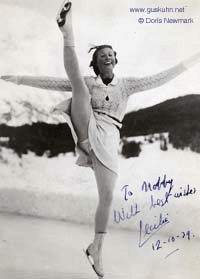|
In most of the Wimbledon team photos of the 1930's, Nobby Clarke can be seen with the great stars of the Dons. He is the fellow in a white coat and is listed as trainer. Nobby's job was what we would now call the physiotherapist, as it was his job to keep the team fit to race.
So why was Nobby so important to the pre-war Dons and why was he held in such great esteem? Nobby was certainly one of the foremost sports trainers in the British Isles before the Second World War. Such was his fame in the sporting world that he was rightly called 'the miracle healer'. The Canadian Ice Hockey players went further as they called Nobby "the best trainer in the world". For over 30 years he trained athletes of all kinds - jockeys, tennis stars, track runners, swimmers, boxers, wrestlers, footballers, ice hockey teams, ice skaters and, of course, speedway riders - in fact all sorts of sportsmen and women.
He was a gruff voiced cockney, as he was born within the sound of Bow Bells, well built with iron-grey hair. When he barked it would sound like a declaration of war; but this was just his gruff but friendly way, for everyone said that "he had a heart of gold". Like all cockneys, he had a great sense of fun and would do his best to keep everyone smiling. Nobby had worked at the London Hospital and was a staff member of the St John Ambulance Brigade. It was in this capacity he attended the meetings and practice at High Beech in that first season of 1928. At the end of 1929 he moved to Lea Bridge and a year later went to Stamford Bridge. Frank Arthur introduced him to International Speedways Ltd, and he became their permanent trainer in 1931. Nobby was therefore the first person to be attached to speedway in this capacity and he then played an important part in the physical condition of the riders. Nobby was given his own dressings room at Wimbledon which was a replica of Arsenal FC's. He was justifiabley proud of his impressive array of equipment, including the new electrical massage gadget. In all, £600 worth of apparatus was installed (a fortune before the war). This included, infra-red rays, radiant heat lamps, Faradic coils and foam baths. One of the most valuable parts of his first aid equipment was an inexpensive child's paintbrush, used to get the cinders out of the rider's eyes. Nobby had his own embrocation for rubbing muscles. It was made up of equal parts of oil of wintergreen and olive oil. When he had rubbed the muscles sufficiently, he would wipe the surplus off with wadding or cotton tissue. That was important, because the wintergreen could burn painfully if left on the skin. He had a great passion for the health effects of oranges and would buy them in cases. He also would have a bottle of strong, sweet lemonade that his charges could take a mouthful of from time to time as a stimulant - sugar and lemon juice are full of vitamins and energy.
On the away trips, Nobby never believed in taking risks as he had a deep-rooted fear of being unable to procure what he regarded as necessary utensils at away tracks. He always included among his equipment an extremely large bucket and a watering can to match. Just what he did with the watering can no one ever found out. The great Vic Huxley had so much faith in Nobby that he would never ride, if he could help it, unless Nobby was in the pits. Once, in a Test Match at New Cross, Vic hit the fence, came down and caught his foot in the back wheel. The machine had to be cut away from him and it was found that two small bones in his foot had been broken. He submitted patiently to an X-ray examination, but after that he would not once see a doctor. He refused point blank to let anyone but Nobby touch him. The very shrewd businessman Mr W J Cearns, who ran Wimbledon, decided to give Vic, his star man, complete rest so he sent him down to Cornwall. He then arranged for Nobby to go down, while Vic's foot was still encased in plaster, and treat him for about three weeks to ensure that the bones should knit perfectly. Each visit entailed a journey of about 500 miles. Nobby also helped Huxley when he injured his ankle. The score was one-all in the British Open Championship. The deciding race was put back about half an hour while Nobby worked on 'Hux' in the dressing room, administering radiant heat and massage. Vic then went out and won the deciding race. It was because of Huxley's faith in Nobby that the Wimbledon management agreed to Nobby's appointment as trainer to Huxley's Australia team in 1931. Max Grosskreutz's rapid improvement was due to Nobby's treatment. At the end of the series the Australians presented Nobby with a lovely plaque, which has a golden, leg tailing rider and the national flags of the two countries. During the 1932 season Vic Huxley formed a scratch team of Australian riders, all of whom were attached to Stamford Bridge and Wimbledon teams. They called themselves 'The Kangaroos' and rode a total of 20 second half challenge matches at various other league teams tracks, winning nineteen and drawing one and, of course, Vic had Nobby as their trainer. In 1933 Bluey Wilkinson had damaged his shoulder in a heavy fall, and on the way to Belle Vue he was worked on by Nobby for practically the whole journey. Nobby had again done his job as Bluey was in good enough shape to go out and race, practically winning the match for his side.
Wimbledon would let any rider be treated by Nobby. Once seven West Ham riders were lined up awaiting attention! That year Nobby did a lot of work for the Hammers and at the end of the season Johnny Hoskins, always quick to acknowledge a benefit, presented Nobby with a clock for the help he had been able to give his team. This clock was presented at the last meeting of the Hammers season. Nobby was told to leave it behind as Johnny hadn't found the time to get it engraved. Believing that it might spoil the clock by being engraved, Nobby's wife decided not to leave it and so Nobby took it home as it was. It was certainly a fine clock and some 60 years later, it still keeps the correct time. There was the time when Nobby was on the train going to a meeting at Plymouth with Frank Arthur who used to suffer badly with his hand. On this occasion he was in a lot of pain and had definitely decided not to ride. However, during the trip Nobby worked his magic on the star and, on arrival at Plymouth, Frank agreed to ride. Not only did he ride but be also set a new track record, which stood unbeaten for some years. As the pre-war tracks had deep cinders surfaces, with riders leg trailing, they absorbed a lot of punishment. There were enlarged joints through accidental blows and damaged ankles caused by dragging the foot in the deep dirt. These, and the deeper-seated bruises, were dealt with by means of the infra-red lamp.
Then there was the common injury to the abductor muscle, when a tendon is torn away from the pelvis through the general jolting and strain as the foot is trailing in the cinders. For this Nobby applied heat and the faradic electric battery, a device of negative and positive electrodes applied to the affected part, which contracts and builds up the damaged muscle. Wal Phillips had painful memories of this injury. He had taken the place of another Wimbledon rider at Plymouth, one night in 1933, when he was sandwiched between another rider and the fence. He tore the tendon completely away and Nobby was sent down to fetch him from hospital by train and ambulance. In 1934, the quietly spoken, rather shy young Suffolk lad, Geoff Pymar joined the Dons. He soon became one of Nobby's most ardent admirers as he adopted a lot of Nobby's recommendation's and followed them to the end of his days. Nobby's advice must certainly have worked on Geoff, as he was still racing in his 50's and he lived to the great age of 90. In his eighties he was riding a pushbike to his local Golf course at Diss and then playing two rounds of golf before setting off back home on the bike. During the winters Nobby became involved in Ice Hockey, working for two years with the Richmond Hawks and the Brighton Tigers. Then, when Harringay opened for the 1936-37 season, he worked for Percy Nicklen with the two Harringay teams, the Greyhounds and Racers. Harringay, of course, had excellent training rooms for the Harringay players. Nobby was proud that he had over £200's worth of medical apparatus with which to cure the players who got injured.
The Great Britain Ice Hockey Team won their first and only World Championship in 1936. That same year they also won Olympic Gold and the European title, which were contested at the same tournament in Garmisch, Bavaria. They were the first nation to do so - and Nobby was their trainer. He also helped Cecilia Colledge who became the British, European and World Ice Dancing champion. On top of all this, he was involved with Metro-Goldwyn-Mayer who had a dancing school at which large numbers of delightful young ladies learnt the dancing arts which entranced theatre and cinema audiences up and down the country. In the winter of 1936-37 Wal Phillips rode in Australia where he sustained a badly broken leg at the Sydney Showground. He then retired from racing and took over as the non-riding captain of Wimbledon for the 1939 season. He resolved to become a qualified trainer, so his friend Nobby took him under his wing during the winter as his assistant at Harringay. Wal was so eager to learn the tricks of the trade that Nobby allowed him to work with him on the ice hockey stars. Nobby and Wal worked a lot on Joe Beaton who was one of the very top ice hockey players. Joe had been the star of the Richmond Hawks until he received a serious groin injury in the 1936-37 season. It then seemed that Joe's magnificent career was over as he returned back to his Canadian home. With the 1937-38 season in its infancy, Percy Nicklin drew Nobby to one side and mentioned Joe to him. Shall we bring him back? Nobby was all for it and the gamble paid off as Joe once more became a leading scorer. With Nobby's helping hands Joe never complained about his old injury. Nobby always kept the hockey boys fit. At one time several of them volunteered to help Nobby with his garden, which he was getting ready for spring, as digging was excellent exercise. Nobby had the most unusual collection of supports for his dahlias and other precious plants. They were the staffs of broken ice hockey sticks and each was prominently lettered with the player's name. Those dahlias were really something as they grew to the size of dinner plates. Nobby, like all gardeners, had problems with earwigs eating the dahlias. The way to stop this was to put flowerpots filled with straw on top of the sticks. As he did not have a lot of spare time he would give his daughter and her friend extra pocket money to get rid of the pots full of earwigs. The trips to Belle Vue Manchester always resulted in a hard meeting but afterwards the fans and some of the riders would enjoy the rides on the famous funfair. The riders liked to try their luck on the various stalls and would often win Teddy Bears. Now a speedway rider would not have a lot of use for such an item, but they knew that, apart from enjoying his garden, Nobby worshiped his blonde haired daughter, Doris, and from an early age her Speedway "Uncles" would come round to see Nobby and leave the bears that they had won at the fairground for her. Because of his connection with the Canadian Ice Hockey players, when the Second World War started in 1939 Nobby was attached the Canadian Army at Purley. During those dark days leave was very infrequent and, when he did get time off, he had to take several trains to get home. On one such trip, during an air raid, there were no trains from Waterloo. Nobby was going home and a German air raid was not going to stop him. So he set off on foot to get to his North London home. Unfortunately, he was injured in the raid and received kidney damage which was to cause his death some time later. The family received condolence letters from all around the world, which just proved how much the sporting world thought of the World's Best Trainer. Many thanks to Keith Farman for his permission to use this article which originally appeared in The Speedway Researcher in June 2007. Also, very special thanks to Nobby's daughter, Doris Newmark, for her assistance in the preparation of this article and for supplying the wonderful pictures. Thanks also to Martin Harris for correcting some facts about Ice Hockey history. He tells us that Cecilia Colledge's brother, Maule, was also an ice hockey player with the Earls Court Marlboroughs. Though he was selected to represent Britain at the 1939 World ice hockey championships, he had to withdraw due to illness. |
||||||||||||||||
